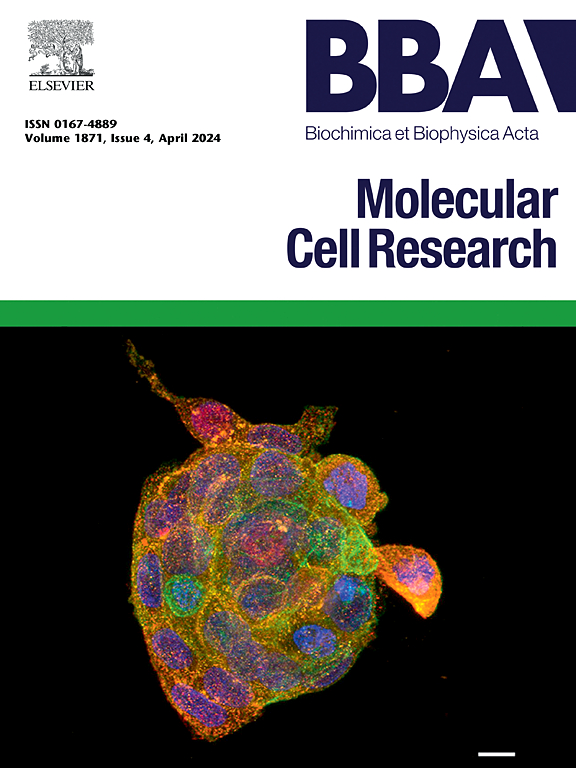缺氧诱导的巩膜成纤维细胞表型转化通过旁分泌作用促进粘附斑块通路的激活,导致脉络膜损伤。
IF 4.6
2区 生物学
Q1 BIOCHEMISTRY & MOLECULAR BIOLOGY
Biochimica et biophysica acta. Molecular cell research
Pub Date : 2025-05-15
DOI:10.1016/j.bbamcr.2025.119992
引用次数: 0
摘要
近视已成为视力丧失的重要原因,其患病率在年轻人群中呈上升趋势。近视的发病机制尚不清楚。本研究通过缺氧诱导人巩膜成纤维细胞(hsf),验证缺氧对hsf表型转化和细胞外基质重塑的影响。随后,在常氧和缺氧条件下提取并验证hsf的外泌体,以探索hsf对人脉络膜内皮细胞(HCEC)的影响。转录组测序分析了hsf影响HCEC的可能分子机制。结果表明,缺氧导致hsf增殖能力降低,促进细胞纤维化,加重氧化损伤。与正常条件组相比,用缺氧诱导的hsf条件培养基或外泌体处理的HCEC组表现出更大的细胞损伤。转录组测序显示,缺氧诱导的hsfs来源的外泌体处理的HCEC中差异表达基因在Focal adhesion信号通路中显著富集。该测序结果经RT-qPCR和Western blot实验验证。我们的研究在体外证明了缺氧诱导hsf表型转化,并通过旁分泌机制导致HCEC损伤,这一过程可能是由粘附斑块信号通路介导的。本文章由计算机程序翻译,如有差异,请以英文原文为准。
Hypoxia-induced phenotypic transformation of scleral fibroblasts promotes activation of the adhesion patch pathway through paracrine effects leading to choroidal damage
Myopia has become an important cause of vision loss, where its prevalence is increasing in the younger population. The pathogenesis of myopia remains poorly understood. In this study, human scleral fibroblasts (HSFs) were induced by hypoxia to verify the effects of hypoxia on the phenotypic transformation and extracellular matrix remodeling of HSFs. Subsequently, exosomes of HSFs under normoxic and hypoxic conditions were extracted and validated to explore the effects of HSFs on human choroidal endothelial cells (HCEC). Transcriptome sequencing analyzed the possible molecular mechanisms by which HSFs affect HCEC. The results showed that hypoxia resulted in reduced proliferative capacity of HSFs, promoted cellular fibrosis as well as aggravated oxidative damage. The HCEC group treated with hypoxia-induced HSFs conditioned medium or exosomes exhibited significantly more cellular damage compared to the normal conditioned group. Transcriptome sequencing showed that differentially expressed genes in hypoxia-induced HSFs-derived exosome-treated HCEC were significantly enriched in the Focal adhesion signaling pathway. This sequencing result was verified by RT-qPCR and Western blot experiments. Our study demonstrated in vitro that hypoxia induces phenotypic transformation of HSFs, and that lead to HCEC damage through a paracrine mechanism, a process that may be mediated by the adhesion patch signaling pathway.
求助全文
通过发布文献求助,成功后即可免费获取论文全文。
去求助
来源期刊
CiteScore
10.00
自引率
2.00%
发文量
151
审稿时长
44 days
期刊介绍:
BBA Molecular Cell Research focuses on understanding the mechanisms of cellular processes at the molecular level. These include aspects of cellular signaling, signal transduction, cell cycle, apoptosis, intracellular trafficking, secretory and endocytic pathways, biogenesis of cell organelles, cytoskeletal structures, cellular interactions, cell/tissue differentiation and cellular enzymology. Also included are studies at the interface between Cell Biology and Biophysics which apply for example novel imaging methods for characterizing cellular processes.

 求助内容:
求助内容: 应助结果提醒方式:
应助结果提醒方式:


